Last fall the exhibition collective, Ethnographic Terminalia, hosted its eighth annual event at the 2015 International Symposium of Electric Art (ISEA) in Vancouver, Canada. Titled ARTIC NOISE, the exhibit, created by Geronimo Inutiq, promised to uphold the collective’s commitment to exposing the shared boundaries of art and the social sciences, namely anthropology. The multimedia installation called upon archival footage from the National Gallery of Canada, on-site research collected from a trip to Igloolik, as well as materials sourced from the artist’s personal collection. Ethnographic Terminalia stated the exhibit was an “Indigenous response to Glenn Gould’s celebrated [documentary] composition The Idea of the North.” In addition, Ethnographic Terminalia offered its audience a workshop, Terminus: Archives, Ephemera, and Electronic Art, to explore the challenges and discourse surrounding the preservation of born-digital art in the archives. The workshop resulted in a handmade catalog, or archive, with future plans to digitize the work for posterity and research.
So, what does this kind of work mean for public historians? I believe Ethnographic Terminalia demonstrates that we can embrace new horizons in our work by challenging notions of historical presentation and ultimately reexamine how we share the past. And we can begin by looking around us, investigating how the humanities, social sciences, and arts interact, share artifacts, and illicit public interaction.
I was fortunate enough to attend Ethnographic Terminalia’s 2014 event, The Bureau of Memories: Archives and Ephemera, at Washington, DC’s Hierarchy Gallery. Described as an investigation of the tension between public memory and history, Bureau of Memories hosted twenty-six unique mini exhibits representing the research of anthropologists and artists, from seasoned scholars to newly minted graduate students. And unlike any historical exhibition I’d previously encountered, their exhibits shared historical objects, oral histories, film and audiovisual art in simultaneously stimulating ways. Everything seemed to be in conversation with its audience in a fashion I’d only experienced in abstract art spaces. In this review, I’d like to briefly highlight three of the mini exhibits that showcased this rethinking of historical interpretation through individualized interdisciplinary approaches.
As a graduate student deeply invested in the field of oral history, I am endlessly fascinated by the outcomes of oral history research, specifically, presenting it to the public. The exhibit Sweet Tea utilized a personal narrative to document E. Patrick Harris’s story as the first Black man from Hickory, North Carolina, to earn a Ph.D. The experimental documentary, produced by Nora Gross and Jack Johnson, was projected on a stencil of E. Patrick Harris; his arms strewn open in a dance-like pose. The film, a video series of Harris revisiting meaningful places in his hometown (cue David Glassberg’s Sense of History), included a trip home to remake his mother’s sweet tea recipe. An audio recording of his oral testimony complemented the film. Harris used this multimedia, multilayered format to explore his coming out experience as a gay Black southerner with such provocative statements as “Most people never forgive themselves for being gay.” Harris’s story not only invited its audience to consider the many experiences of Black gay men from the South, but also “what does it even mean to blur the boundaries between art and science, scholarship and activism, and what’s to be gained from doing so?”[1]
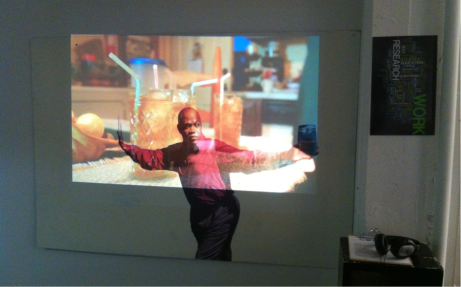 Sweet Tea, Hierarchy Gallery, Washington, D.C., Fall 2014
Sweet Tea, Hierarchy Gallery, Washington, D.C., Fall 2014
As the audience, I felt the exercise of the exhibit was achieved. I let myself drift between the audio, static image, and film while embracing the power of Sweet Tea’s message: activism through self-reflection. To me, this was a fantastic expression of oral history. Utilizing only wall space Sweet Tea interpreted the past while challenging me to understand the history of race, gender, place, and sexuality.
The next mini-exhibit utilized a technique museum director Nina Simon refers to as “social objects.” In her digital book, The Participatory Museum, Simon describes “social objects” as objects that have the ability to “spark conversation.” In other words, “Social objects are the engines of socially networked experiences” and they “allow people to focus their attention on a third thing rather than on each other, making interpersonal engagement more comfortable.”[2]
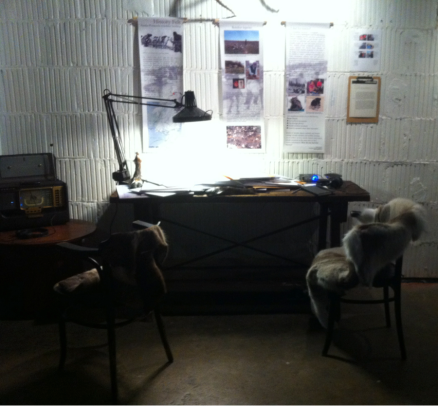 History Felt: Alaska Peninsula Reindeer Herding, Hierarchy Gallery, Washington, D.C., Fall 2014
History Felt: Alaska Peninsula Reindeer Herding, Hierarchy Gallery, Washington, D.C., Fall 2014
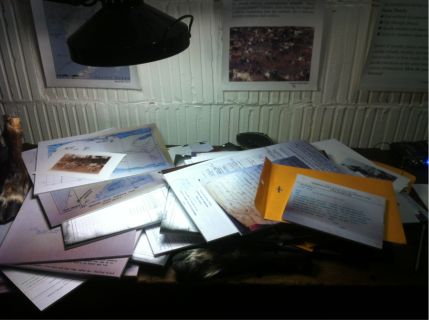 History Felt: Alaska Peninsula Reindeer Herding, Hierarchy Gallery, Washington, D.C., Fall 2014
History Felt: Alaska Peninsula Reindeer Herding, Hierarchy Gallery, Washington, D.C., Fall 2014
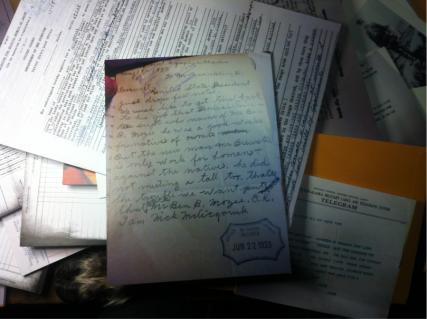 History Felt: Alaska Peninsula Reindeer Herding, Hierarchy Gallery, Washington, D.C., Fall 2014
History Felt: Alaska Peninsula Reindeer Herding, Hierarchy Gallery, Washington, D.C., Fall 2014
Amber Lincoln’s exhibit, History Felt: Alaska Peninsula Reindeer Herding, was the culmination of two-years of research on reindeer herding on the Alaska Peninsula. Using memos, rangeland permits, maps, historical photos, and oral testimonies, Lincoln assembled her exhibit as an office desk. Interpreted as belonging to a reindeer herder, the desk was covered in artifacts, inviting its audience to read and feel its history. Lincoln dropped notes on the desk and pinned maps of herd routes against the wall to address issues of community erosion as herders were drawn to more lucrative industries, like fishing. I watched as the public compared the desk and its contents to that of an acquaintance’s or a beloved grandfather’s, but also delighted in touching the unfamiliar hides of reindeer. Lincoln seemed to latch on to the power of “social objects.” This thoughtful simulation also used an antique phone, much like the one you might find in an old office, to share the personal stories of herders. I observed participants talking with each other about these narratives suggesting that expressing oral sources through a phone was a great example of another “social object.”
Each of the twenty-six mini exhibits offered the audience nuanced visions of history in creative and meaningful formats. Yet, the final exhibit I will recognize in this post achieved a powerful presentation with a familiar and simple “social object” as its focal point: a board game. The Ward: DuBois and Oral Histories, created by Stephanie Brodie and Amy Hillier, aimed to share W.E.B. DuBois’s vision for Philadelphia’s Black community from his book The Philadelphia Negro written in the city’s Seventh Ward. The board game invited the audience to sit down and act out DuBois’s dream while a film of activists and religious leaders from the Seventh Ward played in the background.
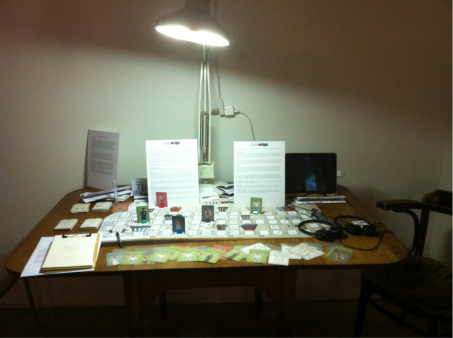 The Ward: DuBois and Oral Histories, Hierarchy Gallery, Washington, D.C., Fall 2014
The Ward: DuBois and Oral Histories, Hierarchy Gallery, Washington, D.C., Fall 2014
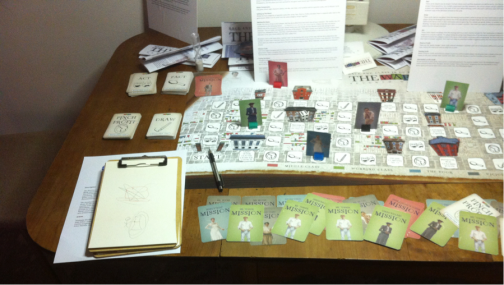 The Ward: DuBois and Oral Histories, Hierarchy Gallery, Washington, D.C., Fall 2014
The Ward: DuBois and Oral Histories, Hierarchy Gallery, Washington, D.C., Fall 2014
The setting was inviting — as if you were welcomed into someone’s home with a television set illuminating your host’s favorite series. Brodie and Hillier’s board game, positioned in the foreground, was well executed and I watched as the audience settled into the activity with ease and interest. The pawns, cards, and board used sophisticated graphics and asked users to choose their piece from a selection of historical community members. As players moved across the board, encountering issues of DuBois’ The Philadelphia Negro, they were lulled by the captivating stories projected on the wall behind them.
***
As mentioned earlier, Ethnographic Terminalia roots itself between anthropology and art. Though it is not explicitly history, its presentation of the past relies on the same objects public historians use to tell stories: maps, images, artifacts, oral testimony, ephemera, film, and more.
To me, this project demonstrates that by keeping attune to the interest of audiences and the practices of neighboring disciplines, public historians stand to benefit a great deal as we continue to reimagine how we share the past with the public.
[1] The Bureau of Memories: Archives and Ephemera, Exhibit Catalog
[2] Nina Simon. The Participatory Museum (Museum 2.0; First Edition (US) First Printing edition, 2010) accessed August 6, 2015, http://www.participatorymuseum.org/read/, chapter 4.